Houseplants were all the rage in the '70s and like all good trends they are back in the limelight after falling slightly out of favour. The greenery and fauna that we may have been separated from due to the pandemic have come creeping into our indoor life creating tranquil, mindful and fulfilling domestic spaces accessible to us at any time.
Monstera deliciosa is one of the most iconic and popular houseplants that you can buy, and did you know it comes in all sorts of shapes and textures? In this article, we're going to explore how to grow Thai Constellation Monstera.
Its presence in your home will instantly contemporise/modernise the dreariest corner of your home. Monstera deliciosa is also known as the Split Leaf Philodendron and the Swiss Cheese plant, although saying the latter doesn't mean it will produce tasty cheese treats to harvest.
More...
What is Thai Constellation Monstera?
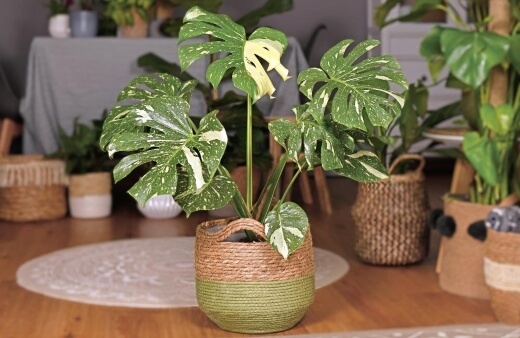
If you're lucky enough to get your hands on a variegated monstera well, I'm variegated-green with envy. This is because they are an elusive and rare plant.
They are not available to buy in your usual houseplant shops and if you find any plants or cuttings on specialist websites or stores they will most probably come with a large price tag.
Variegation in monstera plants is simply created by chance mutations in the genes that stop parts of the leaves from producing chlorophyll.
Chlorophyll is the all-powerful molecule that gives the plant its own beautiful shade of green and is vital for the plant to photosynthesise and create its own food from light.
The variegated strokes of a monstera’s leaves are lacking in these important cells so they don't photosynthesise from these areas. Therefore, these plants may be a little less vigorous in growth habits and require more light than your normal Swiss Cheese plant.
However there is a distinct difference between the forms of variegated monsteras, and this difference can be traced back to their origins.
Origin of Monstera ‘Thai Constellation’
The variations may look similar on all variegated monstera but, believe it or not, Thai Constellation plant was developed in a laboratory in Thailand.
It was created from tissue culture meaning that its mutation is displayed in all of the plant's leaves to a greater or lesser degree. Its variegation is in every cell so this is the most stable form of variegated monstera.
Monstera ‘Albo Borsigiana’ is a natural mutation. Their unique brushstrokes or speckles of variegated colour can't be manufactured or bred which is what makes these plants so valuable.
Their variation can display in only some of the plant's leaves and without constant tending these plants can in fact revert back to the classic all green Monstera which means that their mutation is much less stable.
Different Cultivars of the Variegated Monstera deliciosa
Here are a few different cultivars of the variegated Monstera deliciosa, each one being uniquely patterned and its own horticultural masterpiece:


Get Your Free Guide:
Master Growing Australian Natives eBook
A Must Have Complete Guide for Every Australian Garden
Get Your Free Guide:
Master Growing Australian Natives eBook
A Must Have Complete Guide for Every Australian Garden
Monstera Albo Borsigiana

Source: Pottedpixie.com
Strikingly blocky in its variegation, the colouring has possibly the greatest contrast of all the variegated monsteras as the patterned areas are almost pure white, bold and generous. It could be seen as the Mondrian of the variegated monsteras.
Monstera Aurea Borsigiana
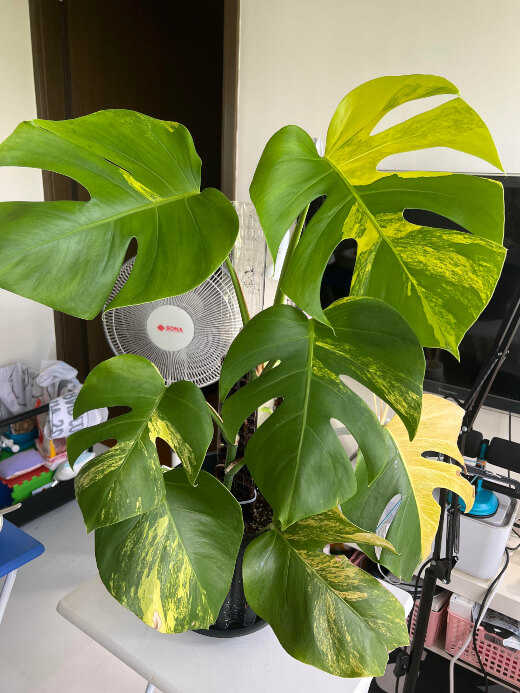
Source: Carousell.sg
Aurea is chemical in its colouring. It's blocky and patchy with bright shades of zesty, electric, lime green. Possibly channelling Lichtenstein with its pop-art leaves, a very contemporary zingy cultivar.
Monstera Mint Borsigiana
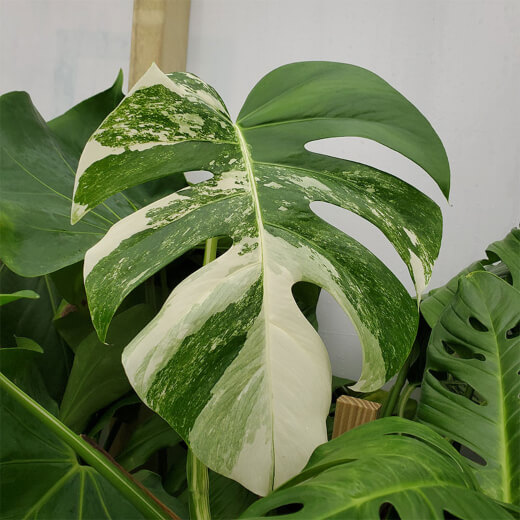
Source: Caynhietdoi.vn
A mixture of both white and green dappled colouring which can be blocky and patchy in its gentle brushstrokes of pastels. You can almost imagine Monet's palette in the leaves of the Mint Borsigiana and the blending shades of thick oil paints.
Thai Constellation Monstera
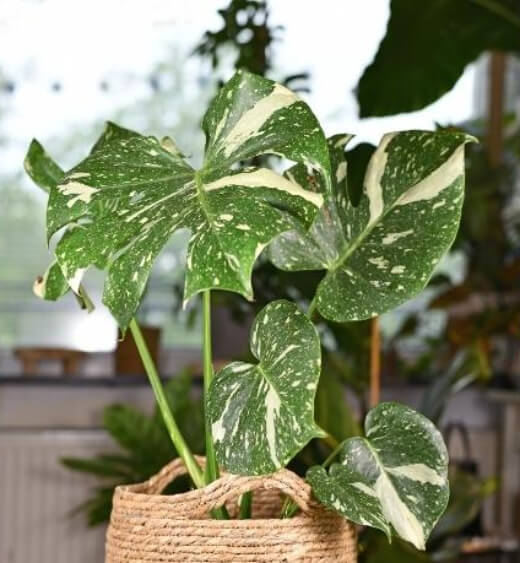
The endless galaxy of the Monstera Thai Constellation is where we want to focus. With creamy light yellows and white explosions, it's just like a Jackson Pollock artwork of speckles and splashes.
The Monstera Thai Constellation is possibly the most popular and most widely available, especially in Australia.
Monstera Albo BorsigianaStrikingly blocky in its variegation, the colouring has possibly the greatest contrast of all the variegated monsteras as the patterned areas are almost pure white, bold and generous. It could be seen as the Mondrian of the variegated monsteras. |  Source: Pottedpixie.com |
Monstera Aurea BorsigianaAurea is chemical in its colouring. It's blocky and patchy with bright shades of zesty, electric, lime green. Possibly channelling Lichtenstein with its pop-art leaves, a very contemporary zingy cultivar. |  Source: Carousell.sg |
Monstera Mint BorsigianaA mixture of both white and green dappled colouring which can be blocky and patchy in its gentle brushstrokes of pastels. You can almost imagine Monet's palette in the leaves of the Mint Borsigiana and the blending shades of thick oil paints. |  Source: Caynhietdoi.vn |
Thai Constellation MonsteraThe endless galaxy of the Monstera Thai Constellation is where we want to focus. With creamy light yellows and white explosions, it's just like a Jackson Pollock artwork of speckles and splashes. The Monstera Thai Constellation is possibly the most popular and most widely available, especially in Australia. |  |
How to Grow Thai Constellation Monstera
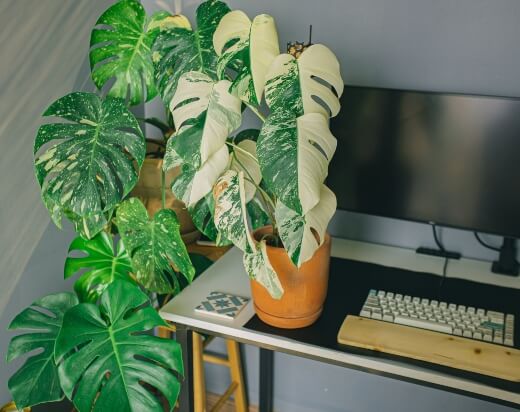
Although they are more widely available than their close relatives, the Thai Constellation plant are still pretty hard to find, and expensive when you do find one!
It is usually sold as a young plant which is a plus for the Thai as the Albo can only be reproduced through cuttings from the parent plant. All versions of this plant are less vigorous than their non-variegated form as these striking patches of white do stress the plant.
In the case of Albo, sometimes these leaves can be fully albino which means that they aren't contributing to the overall health of the plant at all, and therefore will not last very long and be the first to die off.
However, the Thai is a bushier plant with shorter intermodal spacing making it look less vine-like. It has an even and consistent dispersion of chlorophyll in its leaves and has a smaller leaf than the traditional all green Monstera deliciosa.
Thai Constellation Monstera Care Guide
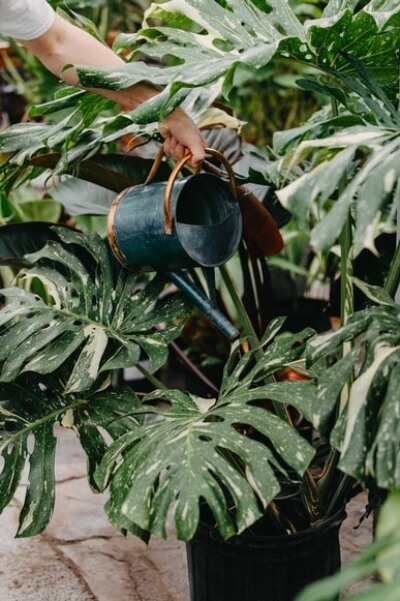
Light Requirements
If you have owned a Monstera delisiosa then you'll know how to care for their variegated relatives. Monstera ‘Thai Constellation’ likes to be in bright indirect sunlight, but also tolerate shade very well. If we journey back to their origin story again, their natural habitat is to be a forest floor spreader in tropical climates.
Monstera will vine across and through other plants and produce aerial roots which will either sink into the earth below or anchor the plant on a neighbouring tree in an epiphytic manner (which is why mature plants often need a moss pole for support).
Although we can't replicate these jungle-like conditions exactly (our homes would end up like Jumanji), providing a humid and bright environment is the best starting point. The Thai Constellation does also follow these same key growing needs.
Although its lack of chlorophyll in the leaves can mean that your plant may need to have more access to light and may not cope well in some of the shadier corners of your home, it still will not want to sit in direct sun as this can scorch its leaves and your expensive young plant may be reduced to a shrivelled mess.
Humidity
Your Thai Constellation will definitely thank you if you give it a warm and humid environment, and in a lot of cases, the best possible place in our homes would be the bathroom.
Bathrooms give out frequent (depending on your hygiene routine) humidity bursts during hot showers and baths which your plant will relish. A brilliant piece of equipment is a room or plant humidifier, sold in all shapes and sizes.
We have many of the little portable humidifiers which you can place around specific plants that love a more humid atmosphere and they occasionally spray out a gentle spritz of water which is very refreshing to be around on a hot day.
Watering Thai Constellation Monstera
As with all house plants, finding the perfect watering routine is key. Firstly if you have access to some collected rainwater this would be ideal, if not then filtered tap water.
Problems can arise from under-watering and overwatering your plant such as root rot and leaf discolouration. If your plant has lots of lovely humidity to draw on then they may benefit from less overall watering as leaves can hold onto their moisture more effectively.
In dry and low humid environments, a more regular watering regime would be needed to keep the leaves from excessive transpiration and losing too much water.
Your plant needs to be able to drink what it needs but drain away what it doesn't!
Soil Requirements
When it comes to soil requirements for your Thai Constellation, they will thrive in a rich peat-free houseplant potting mix. To give your plant the ability to stretch its roots about, add some bark or pearlite which will help in drainage and keep the soil from becoming too heavy.
Again, looking back to its natural habitat, monstera will set its roots in the soil of the forest floor where leaves and plants mulch the ground and create a humus-rich mix.
How to Fertilise Thai Constellation Plant
You have all of your monstera's needs covered, but don't forget that they do need some fertiliser to give them the most balanced diet possible.
They have very lush foliage so all of that beauty needs to be fed to create more leaves to furnish your home and sustain the plant itself. Using a slow-release houseplant liquid fertiliser that's high in nitrogen will ensure strong leaf growth.
How to Propagate Thai Constellation
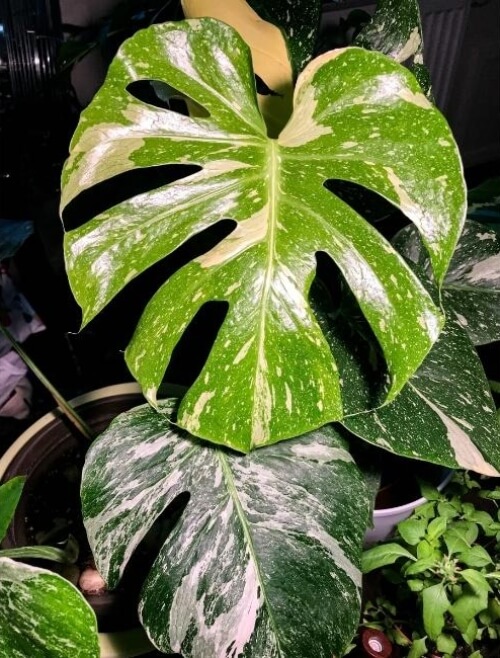
Good news! You definitely can propagate Monstera ‘Thai Constellation’ just like you can propagate Monstera deliciosa. The important thing to know is that they will grow more slowly than the Monstera deliciosa due to the variegation.
When a plant is young it needs all the help it can get so having less ability to produce its own food will mean a slower growth progression.
Monstera ‘Thai Constellation’ Internodal Cuttings
Intermodal cuttings are cuttings taken from a parent plant that includes a leaf and a nodule joint, where the leaf emerges from.
With Thai Constellation Monstera, the spacing in between the nodes can be smaller so caution should be taken to make sure you have enough space for your cuttings and that you're not taking off too much for the plants overall health.
These internodal cuttings can then be calloused at the end and then placed in either water or a free-draining potting mix to create their own roots.
'Wet stick' cuttings
These specific cuttings have a node but no leaf and are often referred to as 'wet sticks' or 'chonks'. They may look like nothing and can still be very expensive for such a small piece of the stem but they do have the ability to root and create a beautiful Thai Constellation plant.
This magic node is the crucial part of the monster's stem that can root by itself. Left to its own growth, your plant would trail all over your house and if it found a suitable place, set out roots. This is what your wet stick is doing.
Without a leaf, your cutting is going to be a lot slower to grow so be patient, and it’s wise to let the ends callous over which will help your small cutting to protect itself whilst growing new roots.
The key to success with these delicate cuttings is to create the right environment which is high humidity but doesn’t over soak it.
Placing your wet stick in a plastic zip-lock bag will keep your cutting nicely humid and encourage those roots to emerge. Including some coconut coir can help to hold the humidity and give your roots something to hold on to.
Thai Constellation Root Separation
The only other way to grow new monstera plants is to separate them by the root. This will only work if your monstera has several visible plants in one pot.
Separating can help to maintain a manageable shape, especially when a mature monstera starts to reach its full size. After watering your monstera, let the soil dry out, this will help to tease the roots away from the others.
Make sure that the plant is supported whilst teasing it away, try to get as many roots as possible. If you don't think you have enough roots to support the size of the separated plant, cutting it back will help take any strain off the small roots whilst the plant bounces back.
You can use a good peat-free and free-draining potting mix for your new plant and choose a pot that will give space for the roots to grow into.
Repotting Thai Constellation
You've been so successful at growing your Monstera ‘Thai Constellation’ that it's outgrown its container and you need to re-pot it. Well done you!
You need to re-pot your Monstera when you see lots of healthy roots poking out of the bottom of its current pot. The best time to re-pot your Thai is in summer during its growing season to make sure it can cope with the transplantation process and quickly put down new roots.
Choose a successive pot that is the next size up from the current pot, if you go too large then there is a chance that the roots will either get overwatered or underwatered in a mass of unnecessary compost.
Make sure to include lots of free-draining material like bark and perlite in a pot with good-sized drainage holes when repotting.
Common Monstera ‘Thai Constellation’ Pests & Diseases
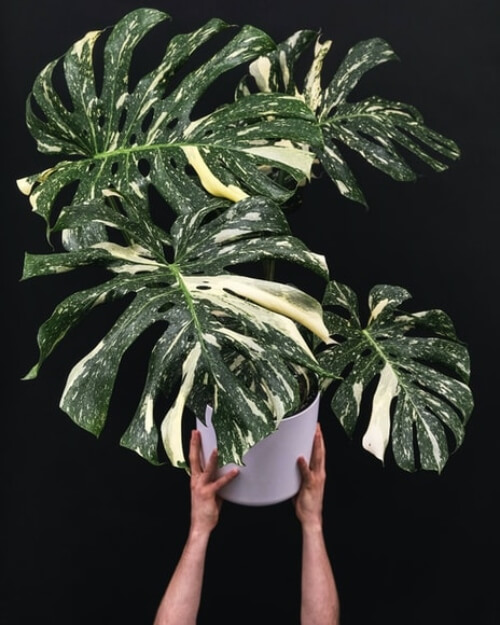
Wherever you grow your monstera indoors or outdoors, there are a few basic pests and diseases to keep an eye out for:
Mealybugs
Mealybugs are one of the classic houseplant pests and are very hard to get rid of without pesticides once they take hold. They look like small white, fluffy bugs that will hide in the crevices of your plant and spread quickly.
Spider Mites
Spider mites are very small but you'll notice webbing on your plant. This is a sign that you may have a spider mite infestation. Like mealybugs, you can use organic pesticides to get rid of them on house plants but unless they are serious infestations, they are unlikely to cause any real harm.
Thrips
Thrips are small, elongated, white insects that could potentially appear like paint flecks and spread quickly and on both the top and undersides of leaves.
All of these pests will feed on parts of your plant and weaken its resources. There are some brilliant methods of control but the first form of defence is offence, keep checking your plant regularly and act as the first sign of any unknown pest!
Some of these methods of control are pretty effective, one of my personal favourites is a mixture of Castile (horticultural soap) and water to wash your plants with and then a solution using Neem oil to smother any insects.
This is our preferred method as it's the most plant-friendly form of tackling the problem if you have a serious infestation.
Blackened Tips
The most likely culprit of blackened tips on Thai Constellation Monstera is your watering routine, potentially your plant has had a bit too much water or left to dry out for longer than it should, the tips turning brown/black are often an indication that your Thai's soil moisture isn't right and could eventually lead to root rot.
Drooping Leaves
This could be as simple as your plant being thirsty or needing extra fertiliser. If you haven't fed your monstera in a while then it could be trying to tell you that it needs a little boost.
If you have just potted up your monstera or moved its location, a sad and droopy looking Monstera could be due to translation shock or acclimatisation.
If you’ve checked the soil for moisture and don’t think it’s under watered or underfed, the other culprit here can be root rot. It’s important to check for any blacked roots by lifting the plant out of its pot just to be safe.
Browning of White Areas
Unfortunately, the gene mutation that makes your Thai Constellation Monstera so unique and beautifully coloured, isn't really helping the plant. Sometimes some leaves that have larger areas of creamy white patches can diminish and turn soft and brown.
This is because these leaves are not as efficient in photosynthesising and it may be better for the health of the plant if these were pruned off.
Luckily this isn't as common in the Thai Constellation compared to naturally variegated monstera, as their leaves photosynthesise more readily.
Thai Constellation Monstera FAQs
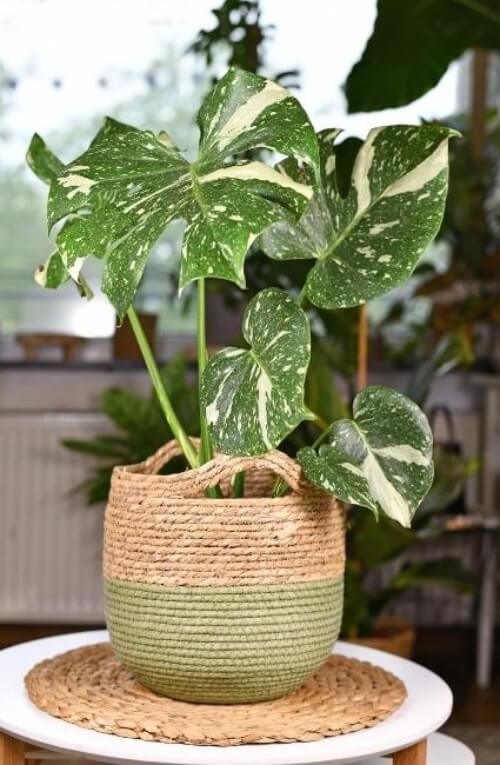
Will Thai Constellation Monstera Revert?
Reversion is when a plant that has unstable variegation reverts back to its original colour. While naturally occurring variations, like in Monstera Albo, are prone to reversion as that variegation is a natural mutation and left to its own devices it may revert back to all green leaves for the health of the plant.
If you want to keep your Albo looking beautifully marbled it does need to have any reverted leaves pruned off. However, the Thai Constellation Monstera won't revert, they are a lot stronger than they may look.
Their variegation is present in every cell in the plant's genes so has no other hereditary imprint to change its course of growth. It will only need to be pruned if any leaves become damaged to stop any disease or infection from taking hold.
Can you grow Thai Constellation Monstera outdoors?
You can grow Thai Constellation Monstera outdoors if you live in a more tropical part of the country. Even if you are further south, your Monstera can happily live outside as long as it's well protected from cold temperatures and frost.
However, with their high price tag, I would keep my Thai Constellation safely indoors as you never know who is walking past with their pruning scissors! There is a small danger of your outdoor monstera catching the attention of harmful bugs which you may not notice until the infestation has taken hold.
But if you’re happy with the risks, start by acclimatising your precious plant to the outside environment first (like you would 'harden off' any tender young seedlings).
Gradually bring your plant outside for a few hours every day slowly increasing its exposure to its new permanent or temporary home.
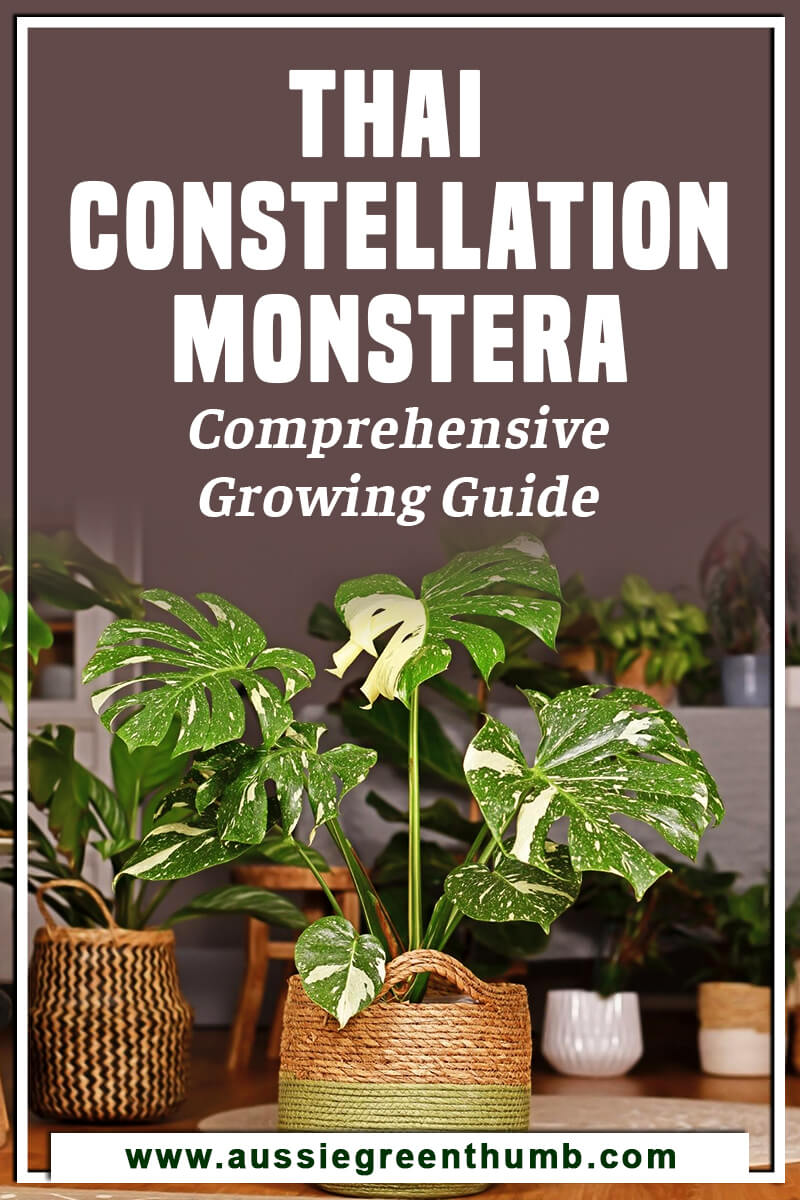
Get Your Hands on Thai Constellation Monstera When You Can
It's probably one of the most sought after and photographed house plants and if you manage to give this beauty a long and healthy life it can actually produce variegated fruit. We’ve yet to see one, but we’re pretty sure we’d die from excitement.
However, you're more likely to find some actual Swiss cheese hanging off your plant than its Deliciosa fruit as it only fruits in perfect conditions and it takes a year to ripen, sorry!
You didn't really need any more persuading, let's be honest. We all want the beautiful variegated Thai Constellation Monstera, but getting your hands on one is another story.
Those lucky enough to have this plant in their collection will hopefully find some useful tips on how to care for the Thai Constellation Monstera above.
Published on February 5, 2022 by Maisie Blevins
Last Updated on February 12, 2024




